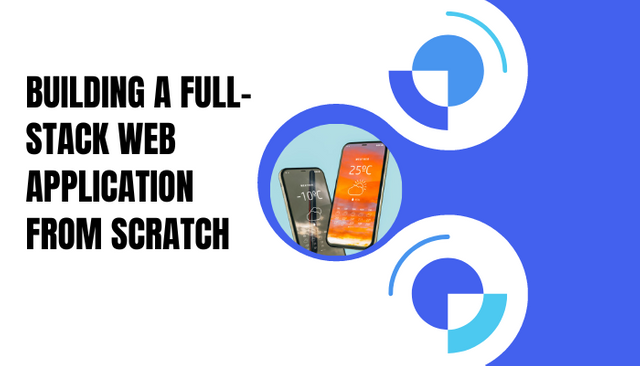Building a full-stack web application from scratch can seem like a daunting task, but with the right tools and knowledge it can be a fun and rewarding experience. In this article, we'll be walking through the process of building a simple full-stack web application, covering the basics of both the front-end and back-end, and providing tips and best practices along the way.
First, let's define what we mean by a "full-stack web application". A full-stack web application is an application that runs on both the client-side (the user's browser) and the server-side (a server that is responsible for processing requests and returning responses).
The front-end of the application, which is what the user interacts with, is typically built using HTML, CSS and JavaScript. On the other hand, the back-end is built using a programming language such as: Python, Ruby or JavaScript.
Before starting to code, it's important to have a clear understanding of the requirements of the application you're building. This includes the functionality and features that you want to include, as well as any constraints or limitations that need to be considered. For the purposes of this article, we'll be building a simple web application that allows users to create and view a list of tasks.

Technologies for building front-end as well as back-ends
To build the front-end of our application, we'll be using HTML, CSS, and JavaScript. HTML provides the structure of the pages, CSS is used for styling, and JavaScript is used for interactivity and dynamic content. To make the process of building the front-end easier, we can use a JavaScript library or framework such as React, Angular, or Vue.js. In this example, we'll be using React.
To build the back-end of our application, we'll be using Node.js, which is a JavaScript runtime that allows us to run JavaScript on the server-side. We'll also be using Express, a popular web framework for Node.js, to handle routing and other server-side functionality. In addition, we'll be using a database to store the tasks that users create. For this, we can use a popular database management system such as MongoDB, MySQL, or PostgreSQL.
Once we have our front-end and back-end set up, we need to connect them. This is typically done using an API (Application Programming Interface), which allows the front-end and back-end to communicate with each other. In this example, we'll be using a REST (Representational State Transfer) API, which is a popular and widely-used type of API.
Process to build an application
To start building our application, we'll first set up our development environment. This includes installing the necessary software and tools, such as Node.js, a text editor or IDE, and a local development server. Next, we'll create the basic structure of our application, including the file and folder structure, and set up the necessary dependencies and packages.
Next, we'll focus on building the front-end of our application. We'll start by creating the basic layout and structure of the pages using HTML, and then adding styles and interactivity using CSS and JavaScript. We'll also set up React and create the necessary components that make up the application.
Once the front-end is complete, we'll move on to building the back-end. We'll start by setting up Node.js and Express, and then create the necessary routes and functionality to handle requests and responses. We'll also set up our database and create the necessary models and methods to interact with it.
Once the front-end and back-end are connected, we can test our application to make sure everything is working properly. This includes testing the different routes, functionality, and interactions between the front-end and back-end. We can use tools such as Postman to test the API endpoints and ensure that the correct data is being returned.
One important aspect to consider while building a full-stack web application is security. We need to ensure that our application is protected against common security threats such as SQL injection, cross-site scripting (XSS), and cross-site request forgery (CSRF). We can use various libraries and frameworks to help us with this, such as Express-Validator for input validation, and helmet.js to set various HTTP headers to help protect our application.
Another important aspect is scalability and performance. As our application grows and more users start using it, we need to ensure that it can handle the increased traffic and load. This includes using a performance optimized database, caching, and using a Content Delivery Network (CDN) to distribute the content of our application to different geographical locations.
Finally, it's important to keep in mind the maintainability of the codebase. This includes using best practices for writing clean and organized code, using version control systems like Git, and having thorough documentation for the codebase and the application.
Conclusion
In conclusion, building a full-stack web application from scratch can be a challenging but rewarding experience. By understanding the basics of front-end and back-end development, using the right tools and frameworks, and following best practices, you can create a functional and visually appealing application that meets the needs of your users.
In this article, we've provided a general overview of the process of building a full-stack web application, including the front-end using React, the back-end using Node.js and Express, and connecting them using a REST API. Remember that building a web application is a complex task and requires a lot of planning, testing, and debugging, but with the right mindset, you can create a successful and effective web application.